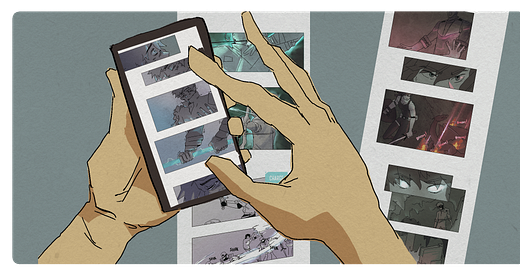It’s 2025 and the webtoon medium is at an all-time high in the international market. Naver WEBTOON is currently dominating the Japanese market with their LINE Manga platform, digital revenue across WEBTOON, Manta, Lezhin and Tapas is peaking year-on-year, and there’s more interest than ever for new content from Korea.
But it’s not enough. And everyone knows it.
The Silent Driving Force Behind Korean Content
KOCCA is the Korea Creative Content Agency and they’re a government funded institution dedicated to promoting Korean content worldwide. They have offices in Korea, France, Mexico, Brazil, Germany, the US and every other market with a market for Korean content.
While KOCCA has always worked behind the scenes to fund literary authors, connect creatives with publishers, and fund overseas initiatives, their size and activity have exploded in recent years.
If you travel to a licensing show or a comic convention and see a cluster of Korean webtoon companies and studios, more than likely, they’re there with the help of KOCCA. Heck, if you see K-pop companies at a licensing convention, they’re probably there with KOCCA, too.
While the bigger companies like Kakao, Naver or RIDI don’t rely on KOCCA, smaller companies, studios, and independent artists receive funding from KOCCA to produce content, attend conventions, and, most recently, produce overseas webtoon contests.
A Change in the Winds
In March 2025, KOCCA announced a preliminary town hall at which they would announce the grants being offered for the webtoon and animation industries for 2025. It was a routine occurrence and there was no expectation for any of the announcements contain any surprises.
But they did. A big one, in fact.
For the first time in their history, KOCCA announced a set of grants aimed at supporting overseas creatives working in the Korean publishing industry. KOCCA grants are only elligible to Korean companies and citizens, but this set of grants focused on companies who licensed or worked with overseas authors and artists to publish webtoons in Korea.
KOCCA’s announcement marked a significant change in Korean content strategy that has already taken place. Multiple studios and publishers like Naver WEBTOON, TOPCO, Kidari Studio, and Kakao Piccoma are already working closely with Japanese studios. Not only that, we’re seeing the trend of Korean webnovels being adapted by overseas studios through Korean content publishers like Contents Lab Blue, Golem Factory, and more.
Trying Something Different
Naver WEBTOON has been publishing webtoons based on foreign webnovels for the past three years. The same goes for Tapas, but their successes have been fewer. And as time goes on, it feels more and more obvious that Green beats Yellow in most markets around the world.

Kidari Studio, on the other hand, is pushing a different direction. With the opening of their shop in Paris and the closing of their NFT-platform, KDKD, it looks like they’re attempting to right the ship. Lezhin remains the biggest cash cow and the US market is the biggest secondary market outside of Korea, but we’ll have to see if they can actually make a larger push into North America or if they’ll have to focus on Europe to get a leg up on their competitors WEBTOON France and ONO.
The push into Southeast Asian and Spanish-speaking markets feel almost completely spent. Pocket Comics’ Thai service has gone over to Kidari Studio while last year Kakao Entertainment closed Piccoma Indonesia, Piccoma Taiwan and Piccoma France. It feels like a foregone conclusion that the SEA market is going used for content production rather than consumption.
So with SEA essentially being closed down, that leaves western markets of which we’ve already seen significant pullbacks in Europe. Basically, that leaves English.
Naver Makes a (Massive) Change
One of the biggest signs of changes in the water was in Naver WEBTOON’s first quarter report. The first line of the First Quarter 2025 Highlights was:
Total revenue of $325.7 million declined 0.3%, driven by decline in Paid Content, partially offset by growth in Advertising and IP Adaptations.
IP Adaptions is easy, think K-dramas, animes, movies and so on. Not to mention the growing slate of J-drama adaptations.
But the “Advertising” is another one because the WEBTOON app has a few key spaces for ads, but they’re not invasive which means there aren’t many placements for ads. That means, at least in traditional terms, there wasn’t much space to grow this revenue channel.
That is until they did away with Daily Pass (cue side-eye).
Looking Forward
So what does this all mean?
It means that the game board has shifted. Instead of focusing on emerging markets, platforms and publishers will be focusing on high-revenue markets and languages. That means we should expect the competition in the English and Japanese markets to increase over the next year while everyone’s still licking their wounds from the Southeast Asian markets.
Not just that, but Naver definitely understands that with four straight quarters of their stock price dropping is a sign of investor confidence, namely they don’t have it. Other companies are certainly going to look at Naver’s actions and (a) see it as a sign of market trends shifting or (b) attempt to capitalize on a new corner of the market that’s opened up.
Korean content is at all all-time high in 2025 with multiple K-dramas being slated for Amazon’s Prime streaming service, not to mention the return of BTS.
And while many companies notched record-highs in 2023 and 2024, the lack of profit was noticeable and some companies have had to rein in spending in each year’s wake. Under normal circumstances, I wouldn’t have expected 2025 to be much different, but Naver’s recent moves and Kakao’s recent troubles create room for opportunity if there’s anyone to take up the risk.






Thank you for this article.
If I can add some details about Kidari Studio : they came on the French market buying Delitoon (the first webtoon app in France) in 2019.
Also they started to produce content with french authors in 2022